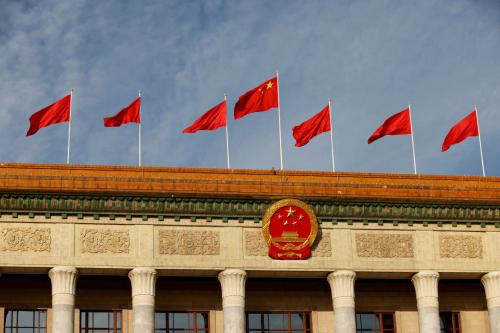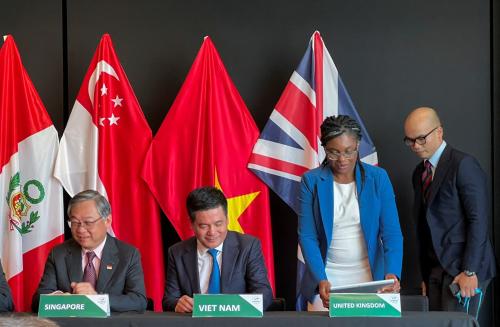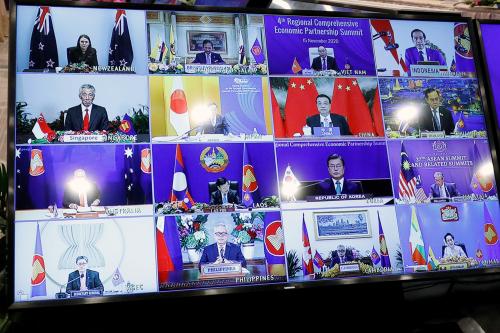The expected summit between Presidents Joe Biden and Xi Jinping in San Francisco in November will feature an unusual backdrop: a Chinese economy in trouble and a U.S. economy that’s surprisingly resilient. But are China’s problems merely a slump, or signs of lasting decline? A wave of publications has already emerged on “Peak China” (here, here, and here) predicting that China will never overtake U.S. GDP, and may even stop growing altogether.
The inner workings of long-term projections are often obscure, but Roland Rajan and Alyssa Leng of the Lowy Institute offer a professional roadmap and help narrow the range of uncertainty. They start with a growth-accounting model for China with a 6% growth rate for real GDP, the pre-pandemic average, and then carefully estimate changes in the determinants of China’s growth in the years ahead.
Some factors, like demographic change, are reasonably predictable: A 1.7% annual growth in China’s working-age population between 1980 and 2010 will turn into a 0.9% annual decline from now to 2050. Other factors, especially those that affect the productivity of future investments, are critical but uncertain. The latter define much of the variation in the outlook. (An important caveat: Large technological or geopolitical surprises are not considered.)
Based on conservative assumptions, the Lowy study concludes that the most likely outcome is a deceleration to 2%-3% average annual growth in real Chinese GDP through 2050, but doesn’t rule out rates of up to 5%. These averages include higher early growth rates and declining ones later. Starting with U.S. and Chinese GDP levels of $25.5 trillion and $17.9 trillion in 2022, with 2% U.S. and 2% Chinese real growth, U.S. GDP would be still 42% larger than Chinese GDP in 2050, but with 5% Chinese growth, Chinese GDP would be 58% larger (assuming constant real exchange rates).
Inside the model, China’s low and high alternatives differ mainly in assumptions about the size, sectoral composition, and productivity of future investments. These, in turn, will depend on economic strategy — whether it remains, as now, closely held and ideologically directed, or elevates private decisionmaking and market opportunities. We explore these alternatives in the current context below.
The real estate crisis
China is in a deep real estate crisis. Sales, construction starts, and investments are plummeting, and few major developers will survive without massive bailouts. A large bubble — based on decades of investments chasing fast growth and price rises — is deflating, partly as a result of government policy, and leaves behind stunning examples of overbuilding. And China’s real estate sector is huge, with estimates ranging up to 29% of GDP.
The most prominent Chinese real estate developers — Evergrande, Country Garden, and Sunac — are among the many firms inching toward bankruptcy. Two-thirds of developers who borrowed internationally have already missed payments on foreign debt. More bad news lies ahead: Real estate prices have been artificially supported by the government, and when they eventually fall more losses will need to be recognized.
Since 70% of China’s household wealth is held in real estate, it will take years to rebuild consumer confidence and lost purchasing power. China is also facing a comparable problem with local government debt, which amounts to nearly one-third of GDP and is backed by rapidly falling land-sale revenues.
Severe as this debt crisis is, the government is likely to contain it without threatening the Chinese financial system. The system is built around the world’s four largest banks, holding assets nearly equal to U.S. GDP. All are state-owned, have access to government capital, and operate under state directives. The state ultimately controls the resources and rules needed to restructure distressed companies and allocate losses — and keeps a close eye on financial stability.
State-led crisis management is already underway in both real estate and local government finances. For example, Evergrande’s CEO and other top executives have been removed, but the company continues to get money to complete pre-sold but unfinished projects. The government can also mobilize fiscal support quickly, as illustrated by a new package. (A report on the just-concluded Central Financial Work Conference by Zichen Wang and Jia Yuxuan offers more institutional details.)
The root problem
Yet muddling through the finances of the debt crisis will not solve its structural causes. China is investing too much in unproductive projects and consuming too little. This is a legacy of extraordinary 10.5% annual growth between 1990-2010, which would not have been possible without very high rates of investment. The problem has been long recognized, but investment today is still 43% of GDP while growth is projected to fall to 3.9% annually over the next five years (values in this paragraph are based on IMF data).
Decades of massive infrastructure and real estate investments have exhausted the backlog of high-productivity projects and are now dragging down the economy. China’s growth will not rebound enough to justify high investments; the economy is slowing for fundamental reasons including an aging population, less rural-to-urban migration, and the shift in demand toward services.
Still, a maturing Chinese economy could prosper and grow by shifting resources to productive business investments and to public and private consumption. But if the property sector, estimated to be 29% of GDP above, were to decline by one-third, about 10% of the Chinese production would have to be disrupted and replaced by new activities.
The scale of this transition cannot be overestimated; it would bring wide-ranging dislocations in production, employment, markets, investments, and household and government budgets. Its success would depend on complex institutions: a financial system that rewards productivity regardless of ownership, scope for decentralized business decisions, and disciplined public spending.
China’s storied investment-fueled growth model has run well past its expiration date, in part due to unexpected shocks like the global financial crisis and the pandemic. It will be difficult to replace, but further delay would only make the transition harder.
Solutions and ideology for China’s growth
While China’s growth was still led by property and infrastructure investments in the early 2010s, many new industries were also appearing, serving middle-income consumers, and creating new investment opportunities. The list is familiar: solar power, traditional and electric vehicles, innovative electronic devices, and state-of-the-art online services in commerce, leisure, transport, and education. A powerful ecosystem was emerging to support entrepreneurs, including venture capital markets with few rivals except in the United States. These were the new foundations of long-term growth.
By the end of the 2010s, however, the political climate had changed, often at the expense of China’s new industries. In speeches starting in 2015, President Xi Jinping revived an ideological approach to economic policy, focusing first on income inequality, but soon prioritizing technological self-sufficiency, national security, and the primacy of the Chinese Communist Party and its leadership.
The implementation of this strategy was jarring. In preparing for the 2023 National People’s Congress, Xi reined in decisionmaking and unveiled a wide, control-centered agenda. The share of state-owned enterprises in bank lending rose from 36% to 83% between 2010 and 2016, and the party tightened its oversight of private enterprises and intimidated foreign firms. Business decisions, from products to finance and leadership, slipped from private to party hands. As a result, domestic and foreign business confidence in China fell and China is now recording the largest capital outflows since 2015.
Course change ahead?
China’s recent strategies inhibit business investment and productivity advances and are already slowing economic growth. Forecasts that expect these policies to continue indefinitely predict growth at the low end of the Lowy range.
But China could grow faster. Three decades is a long time, and Chinese pragmatism could return — underperformance might even make this likely. Forecasts that leave room for a rebound in private initiatives and investments would raise China’s growth outlook at least into the middle part of the Lowy range. True, massive policy reversals are rare in China, but they have happened, even during Xi’s tenure (i.e., “zero-COVID”).
As Martin Wolf argues, economics alone leaves plenty of headroom for China’s catchup. Japan, Korea, and Taiwan’s GDP growth did not slow dramatically when they passed China’s current per capita income level, and their incomes are now more than twice as high. Since many Chinese provinces have already acquired advanced and even frontier technologies, China could also benefit from simpler, within-country transfers of best practices.
For now, China’s plausible long-term growth projections agree on several factors that imply significant deceleration, but disagree on distant, future policies. These commonalities and differences explain a 2%-5% range in GDP growth rates to 2050. If results fall in this range, China will neither dominate nor disappear from global economic leadership, but outcomes at the lower end would represent large shortfalls relative to its economic potential.
The Brookings Institution is committed to quality, independence, and impact.
We are supported by a diverse array of funders. In line with our values and policies, each Brookings publication represents the sole views of its author(s).








Commentary
Peak China: Why do China’s growth projections differ so much?
November 3, 2023